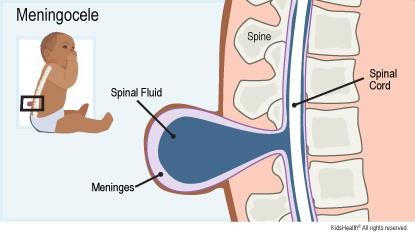A nurse is caring for a newborn who was born 6 hr ago.
Complete the diagram by dragging from the choices below to specify what condition the newborn is most likely experiencing, 2 actions the nurse should take to address that condition, and 2 parameters the nurse should monitor to assess the newborn's progress.
The Correct Answer is []
Potential condition
Correct Answer: B. Meningocele
Rationale: Based on the provided physical examination details, the newborn is most likely experiencing a meningocele, which is indicated by the presence of a sac in the lumbar area. This condition is a type of neural tube defect where a sac of fluid comes through an opening in the baby's back. However, the absence of other neurological symptoms and the intact reflexes suggest that the condition has not severely affected the newborn's neurological functions.

Actions to Take (2)
Correct Answers: C, E
The two actions the nurse should take to address this condition include: applying a non-adhering sterile saline moist compress to the sac to prevent it from drying and to protect it from trauma, and educating the guardians about the condition, its implications, and the potential need for surgical intervention to repair the defect.
Parameters to monitor
Correct Answer: A, C
Rationale: The two parameters the nurse should monitor to assess the newborn's progress are the head circumference and serial head ultrasounds. Monitoring head circumference is crucial as an increase may indicate hydrocephalus, which can be associated with meningocele. Serial head ultrasounds are necessary to assess for any changes in the brain structure or development of hydrocephalus. These measures will help ensure that any complications are identified and managed promptly.
Nursing Test Bank
Naxlex Comprehensive Predictor Exams
Related Questions
Correct Answer is {"dropdown-group-1":"C","dropdown-group-2":"B"}
Explanation
The nurse should anticipate a provider prescription for an antiviral medication, as evidenced by the client's presentation of small pinpoint open vesicles and pustules on the labia majora, which are indicative of a herpes simplex virus infection, a common cause of genital ulcers. The clear drainage and absence of pain are consistent with this diagnosis. Additionally, the thick, mucopurulent discharge could suggest a secondary bacterial infection, for which the provider may prescribe antibiotics.
Antiviral medication is likely prescribed for perineal lesions because these can be indicative of a viral infection, such as herpes. The nurse should recognize the need for antivirals to manage and treat the underlying cause.
Correct Answer is B
Explanation
- A. Administer oxygen via face mask.
- Administering oxygen can be beneficial as it increases maternal oxygenation, which can improve fetal oxygenation. However, it is not the first-line action for late decelerations.Late decelerations are a sign of uteroplacental insufficiency, and while oxygen helps, repositioning the mother is more critical to address the root cause. Oxygen administration is a supportive measure but does not directly address the potential compression of the umbilical cord or placental perfusion issues.
- B. Position the client on her side.
Positioning the client on her side, specifically the left side, can improve uteroplacental circulation, addressing the cause of late decelerations.This position helps to relieve pressure on the inferior vena cava, enhancing blood flow to the placenta and fetus.It is a non-invasive, immediate intervention that can potentially correct the issue of late decelerations quickly.
- C. Increase the infusion rate of the IV fluid.Increasing the infusion rate of IV fluids can improve maternal blood volume, potentially improving placental perfusion.However, this action is not as immediate in effect as repositioning the client and is considered a secondary measure.It may be used in conjunction with other actions but should not be the priority intervention for late decelerations.
- D. Elevate the client's legs.
Elevating the client's legs can increase venous return to the heart, potentially improving maternal cardiac output and placental blood flow.However, this action is less effective than lateral positioning in addressing uteroplacental insufficiency.It is not the first-line response for late decelerations and may not provide the immediate correction needed.
Whether you are a student looking to ace your exams or a practicing nurse seeking to enhance your expertise , our nursing education contents will empower you with the confidence and competence to make a difference in the lives of patients and become a respected leader in the healthcare field.
Visit Naxlex, invest in your future and unlock endless possibilities with our unparalleled nursing education contents today
Report Wrong Answer on the Current Question
Do you disagree with the answer? If yes, what is your expected answer? Explain.
Kindly be descriptive with the issue you are facing.
